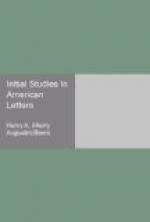In 1847 was published the long poem of Evangeline. The story of the Acadian peasant girl, who was separated from her lover in the dispersion of her people by the English troops, and after weary wanderings and a life-long search, found him at last, an old man dying in a Philadelphia hospital, was told to Longfellow by the Rev. H. L. Conolly, who had previously suggested it to Hawthorne as a subject for a story. Longfellow, characteristically enough, “got up” the local color for his poem from Haliburton’s account of the dispersion of the Grand-Pre Acadians, from Darby’s Geographical Description of Louisiana and Watson’s Annals of Philadelphia. He never needed to go much outside of his library for literary impulse and material. Whatever may be held as to Longfellow’s inventive powers as a creator of characters or an interpreter of American life, his originality as an artist is manifested by his successful domestication in Evangeline of the dactylic hexameter, which no English poet had yet used with effect. The English poet, Arthur Hugh Clough, who lived for a time in Cambridge, followed Longfellow’s example in the use of hexameter in his Bothie of Tober-na-Vuolich, so that we have now arrived at the time—a proud moment for American letters—when the works of our writers began to react upon the literature of Europe. But the beauty of the descriptions in Evangeline and the pathos—somewhat too drawn out—of the story made it dear to a multitude of readers who cared nothing about the technical disputes of Poe and other critics as to whether or not Longfellow’s lines were sufficiently “spondaic” to represent truthfully the quantitative hexameters of Homer and Vergil.
In 1855 appeared Hiawatha, Longfellow’s most aboriginal and “American” book. The tripping trochaic measure he borrowed from the Finnish epic Kalevala. The vague, child-like mythology of the Indian tribes, with its anthropomorphic sense of the brotherhood between men, animals, and the forms of inanimate nature, he took from Schoolcraft’s Algic Researches, 1839. He fixed forever, in a skillfully chosen poetic form, the more inward and imaginative part of Indian character, as Cooper had given permanence to its external and active side. Of Longfellow’s dramatic experiments, the Golden Legend, 1851, alone deserves mention here. This was in his chosen realm, a tale taken from the ecclesiastical annals of the Middle Ages, precious with martyrs’ blood and bathed in the rich twilight of the cloister. It contains some of his best work, but its merit is rather poetic than dramatic, although Ruskin praised it for the closeness with which it entered into the temper of the monk.




